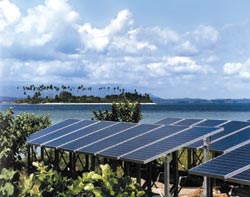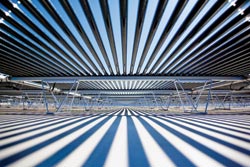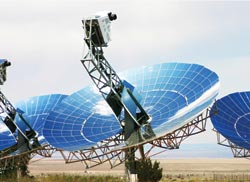The silicon traditionally used to make solar panels is costly and inefficient at converting sunlight into electricity, experts say, yet it remains the material most commonly used to make solar panels.
“This sounds rather ugly, but silicon is the best choice we have at this time,” remarked John Benner of the National Renewable Energy Laboratory (NREL) in Golden, Colo., a US government facility responsible for developing and promoting solar technologies. “It delivers the best combination of performance, cost and reliability for most applications,” he added.

Underdeveloped regions of Indonesia have been benefiting from remote solar power supplies for some time. This system has been in place for at least three years. Courtesy of Schott AG.
Someday solar could compete dollar-for-dollar with traditional power plant sources of energy – a dream known as “grid parity.” Most experts agree that government support is needed to achieve grid parity, even with the progressive improvement of solar cells, although cheaper and more efficient materials will help significantly.
“Many companies expect to beat the US goal of reaching grid parity by 2015. Some project as early as 2012,” Benner said. “With the current economic slump taking margins out of all links in the supply chain, it could happen even earlier.”
The primary cause of the economic downturn of the solar industry this year is, surprisingly, its popularity. The “gold rush” spurred a “Wild West mentality among market participants,” commented iSuppli principal analyst Henning Wicht. The emergence of competitors caused the supply of solar panels to greatly exceed the demand, and iSuppli projects that one of every two solar panels created will not be sold by the end of this year. Not helping matters is the recent collapse of the once-leading solar market of Spain, due to the discontinuation of subsidies.
Price wars
While the price of solar panels has fallen to $4 per silicon wafer so far, the price of solar-grade silicon has remained at $40 per kilogram on average. Solar cell manufacturers are getting hit from both sides.
The high price of solar-grade silicon is primarily the result of factories producing less silicon than is needed to accommodate the demand from solar cell manufacturers and computer chip makers, which compete for the same raw material.
The lack of production is unexpected given that silicon is one of the most abundant materials on earth, most commonly found in sand and quartz, and given that the method of obtaining silicon is easy in principle: Simply melt some sand or quartz.
On an industrial scale, however, sand typically is melted with carbon in the form of coal in a furnace heated to an extremely high temperature such as 1400 °C (2600 °F). The carbon binds with the oxygen gas to form carbon monoxide gas, and what is left is pure silicon. Variations on this process have been developed, but this is essentially what happens.
Because the purest silicon is also the most efficient at converting solar energy to electricity, solar cell manufacturers demand the highest purity, which bumps up the price.
The silicon in demand is crystalline, which is more efficient than amorphous silicon. Polycrystalline silicon is cheaper and easier to make than monocrystalline silicon, and not much efficiency is sacrificed, which is why pure polycrystalline silicon is the most popular material for making solar cells today.
Boron typically is added to the silicon before it solidifies, and phosphorus is added to the top surface of the panel. Boron gives the wafer a positive charge, and phosphorus gives the surface a negative charge.
In the sun, photons of light transfer their energy to the phosphorus, and the outer electrons in the phosphorus atoms move down to the boron atoms. This permanent displacement of electrons creates a fixed electric field between the top layer of silicon and the rest of the silicon wafer.
This permanent electric field is another important reason for choosing a semiconductor such as silicon because, in a conductor, the electrons would dissipate, and no permanent electric field would form.
This electric field pushes free electrons to the front of the solar cell for a net 0.5 V of electricity per cell. This minuscule voltage is why solar cells usually are soldered together into a module that generates substantially more electricity.
Battling for thin-film domination
In California, both Solyndra of Fremont and Nanosolar of San Jose sell thin-film solar cell modules made from the alternative semiconductor CIGS (CuInGaSe2), navigating around the use of pricey solar-grade silicon. Thin films reduce the cost of the material because less is needed and because they can be manufactured in inexpensive roll-to-roll processes.

Photo: Solyndra makes tubular CIGS thin-film solar cells for the rooftop market. Courtesy of Solyndra.
The reported sunlight-to-electricity conversion efficiencies have been up to 10 percent for thin films and up to 15 percent for typical polycrystalline silicon cells, so thin films generally have been less efficient but cheaper.
Nanosolar claims that its efficiency is up to 16 percent, and Solyndra claims that the efficiency of its solar panel is up to 14 percent when rolled out and from 25 to 100 percent when in its tubular modules.
Solyndra CIGS thin films are rolled into a glass tube surrounded by an additional layer of material encased in another glass tube that concentrates the sunlight from all directions. Light that passes through the tubes and is reflected from the roof of the building is collected by the tubes, especially if the rooftop is painted a reflective color such as white. “We designed this for the rooftop as a system,” said Kelly Truman, vice president of marketing and business development for Solyndra. Truman added, “In California, there is a legal requirement for the roofs of new buildings to be painted white. We are riding off that.”
Whereas conventional solar panels act like sails blowing in the wind and must be tacked down with additional material, the tubular solar cells sold by Solyndra are set down as if on a tabletop.

This solar power system from Schott is in use in Gansu, China. Courtesy of Schott AG.
In 2008, Solyndra’s tubular design won a Prism Award for Photonics Innovation from SPIE and the publisher of Photonics Spectra. This award was selected by a panel of independent experts.
Truman said Solyndra has been shipping internationally since July 2008 with increasing volume and revenue each quarter. Solyndra has received a US Department of Energy loan to build a second factory.
First Solar claims that it has sold 1 GW of CdTe thin-film panels with a CdS window layer and also that its manufacturing costs are less than $1 per watt. The company said its efficiency at the end of 2007 was 10.6 percent. If the claim of 1 GW is true, then First Solar is the leading producer of thin-film solar cells, followed by United Solar Ovonic of Rochester Hills, Mich., and Sharp Corp.
Plastic stands alone
A year after winning the 2000 Nobel Prize in chemistry with Hideki Shirakawa and the late Alan MacDiarmid for discovering and developing conductive polymers, Alan Heeger became a founder of and chief scientist at Konarka Technologies, maker of conductive polymer solar cells called Power Plastic.
Power Plastic solar cells are lightweight, flexible and easily integrated into other materials. They cost about one-third less than traditional silicon solar cells and, at one to two ounces per square foot, could win a competition in the lightweight category.
Konarka’s solar cells can be colored and patterned. This year the company began selling its plastic thin films for consumer applications such as battery chargers for mobile phones and other electronic devices; indoor sensors and labels; and outdoor awnings, tents and umbrellas. The 6.4 percent efficiency of the plastic cells is not quite competitive yet for the rooftop market, although it is notable that this figure was verified independently by NREL.
Tracy Wemett, a Konarka representative, emphasized that Konarka makes Power Plastic using traditional roll-to-roll inkjet printing, as opposed to thin-film deposition in which materials are thrown into the air. Therefore, its process is more environmentally friendly.
Some companies, such as Dyesol of Australia, are selling what are called dye-sensitized solar cells – a semiconductor coated with a dye, usually a proprietary chlorophyll analog. These are currently in mass production.

The Suncatcher solar concentrator marketed and sold by Tessera is made by Stirling Energy Systems. Courtesy of Tessera Solar.
Other materials – such as carbon nanotubes, quantum dots and black silicon – are promising for solar cell applications but are still in the R&D stage.
Cyrium Technologies claims it has used quantum dots and semiconductor multijunctions – amalgamations of semiconductor materials – to achieve more than 40 percent efficiency and is providing its product on a qualified evaluation basis.
Jim Carey, co-founder of Sionyx, a Boston-area company that makes black silicon, said his product is being provided on a qualified evaluation basis as well. Black silicon absorbs more of the spectrum than traditional silicon and therefore potentially can convert more sunlight to energy. Infrared-absorbing cells could produce energy even after the sun goes down.
Still fighting
Alternatives may be trying to push silicon aside, but silicon is still going to put up a good fight. Suntech and Suniva now claim to have achieved efficiencies of 17.2 and 18.5 percent, respectively, with their polycrystalline solar cells. Concentrators such as dishes and halfpipes with mirrors designed to reflect concentrated sunlight onto solar cells have been demonstrated to increase efficiency up to about 40 percent. Amorphous silicon thin films – not quite as efficient as crystalline silicon, but cheaper – have been developed to compete with some thin-film technologies.